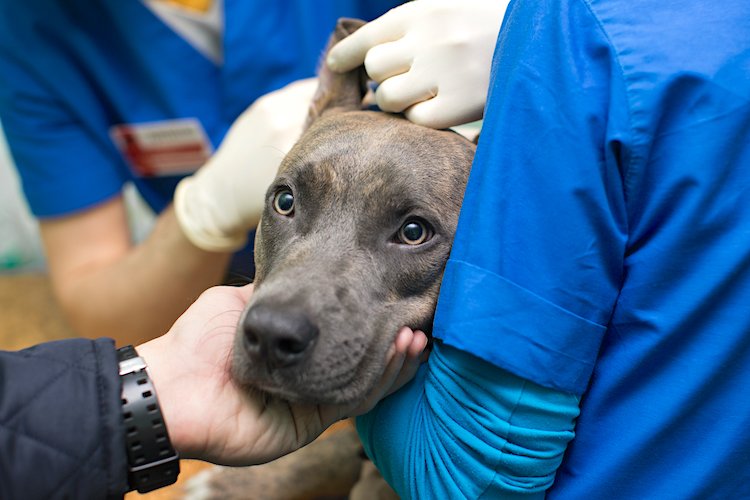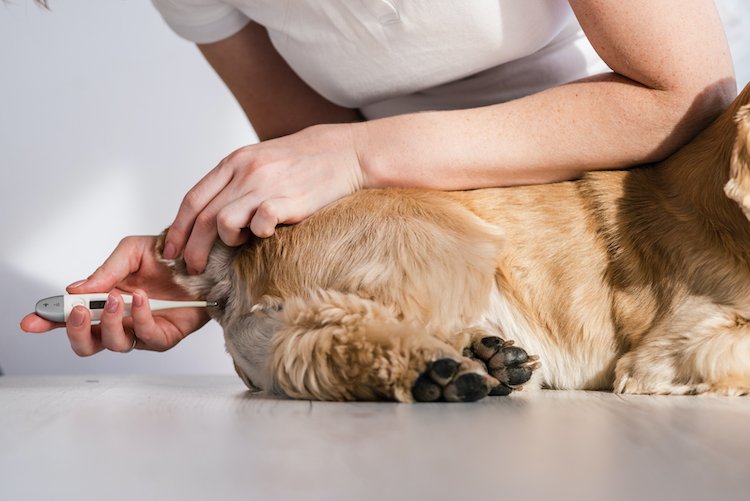How to Use a Dog Thermometer
If your dog seems sick, you may want to learn how to use a dog thermometer. But don’t just poke around blindly — you could hurt them! Here’s what to do.

Ever wondered how to use a dog thermometer?
Knowing how to take a dog’s temperature is a useful skill. It’s not something you need to do every day. But if the dog seems ill, knowing they are running a temperature makes it clear cut to visit the vet.
And there are other uses, such a predicting when a pregnant dog is about to whelp.

Don’t leave your pet’s safety to chance
Sign up for Petful recall alerts today.

Why Take a Dog’s Temperature?
Let’s not get too anal about this. (See what I did there?)
Your job is to be a loving caregiver to your 4-legged companion, and taking their temperature isn’t for everyone. If this is something that makes you go “Eww” or you lack the confidence, then leave this to your vet to do. Better to leave well enough alone than risk hurting the dog.
However, that said, there are occasions when knowing your dog’s temperature is very useful.
- Is the dog sick? A raised temperature can be a sign of infection or inflammation. If it’s not a hot day and they’re running a fever, then it’s important to find out why. For the slightly off-color dog, identifying that their temperature is high is a strong hint they need to see a vet.
- Is your pregnant dog about to have pups? The big day is getting close. It would be really helpful to know if you can go to work today without missing the birth. Well, taking her temperature can help. According to Small Animal Pediatrics, a pregnant dog’s normal rectal temperature is between 100.5 F (38 C) and 102 F (28.9 C). About 24 hours before labor begins, though, “the rectal temperature drops nearly 2 degrees to 99 F (37.2 C) or below.”
- Struggling in the heat: Dogs don’t sweat like humans, and their main way of losing heat in hot weather is to pant. It can be difficult, especially in flat-faced breeds, to know if panting is doing the trick or if they are developing heat stroke. Again, the gold standard is taking the dog’s temperature. Spotting a raised temperature early makes it possible to actively cool the dog and prevent heat exhaustion.

Safety for Pet and People
Again, bear in mind that not all dogs will be thrilled by the prospect of a sudden invasion of their “privacy.” If your dog is likely to object and snap or bite, then best leave it to the professionals. Keep yourself safe.
- Enlist the help of a friend: Veterinarians rarely take a dog’s temperature single handed, and there’s a reason for this. Most dogs’ natural instinct is to sit down when you start fiddling “down there.” An assistant passing their hand under the dog’s belly to keep them in a standing position is invaluable. The friend should gently hug the dog to them, which reassures the dog and reduces the amount of wriggling.
- Consider a muzzle: If it’s imperative to check the dog’s temperature but you don’t trust them not to snap, then consider using a muzzle. Ideally, train them to accept a muzzle happily, before the event. But if this means a wrestling match, probably best not to go there and again … leave it to the professionals.
Likewise, if you find it difficult to place and pass the thermometer, never force the issue. Stop and try again later. The last thing we want is to hurt the dog and do more harm than good.
Buying a Dog Thermometer
The golden rule here is to buy a thermometer specifically to use on the dog — and then LABEL IT.
The reason behind this should be pretty clear: Bearing in mind where that thermometer is going, you really don’t want this getting into the human first-aid box.
OK, so these days digital thermometers are pretty much all you can buy. These newer thermometers have the advantage because they take a reading much more quickly than a mercury one, which means less wriggling and everything is over quickly.
Look for a digital thermometer with a slightly bendy tip. These are a bit more forgiving than the totally rigid ones if the dog happens to move at the wrong moment. It doesn’t really matter if you buy a human or pet thermometer, as long as it has this feature.
They all do the same job and have a broad enough range of temperature readings to work in your pet pal.
Proper Preparation When Using a Dog Thermometer
The more confident and prepared you are before reaching for the dog, the better things will go.
If the dog picks up on your uncertainty, they are liable to play up, adding a whole new level of difficulty.
The first step? Be familiar with the dog’s anatomy — that is, where their butt hole is and the path the rectum takes. Now, the former sounds silly and obvious, but it isn’t. If your dog is very hairy, it can be difficult to find their bottom. Also, once you identify the anus, pigment can make it tricky to be certain where the hole is.
If in doubt, either wet their fur back with water or trim it so that everything becomes clear. Likewise, if you’re not sure where the hole is, try tickling the dog’s rear to make them “wink.” The target is at the center of that wink. (Insider top tip there!)
So what’s this about the path of the rectum?
Well, the rectum is the end part of the bowel where feces sit waiting to be launched out into the world. This tube runs parallel to the dog’s backbone.
It’s important to know this because the thermometer is going to sit inside the rectum. This means when inserting the thermometer, you need to keep it parallel to the backbone, which should be roughly horizontal in the standing dog.
Not to do this, and to poke the thermometer vertically or off to one side, and you are going to hurt the dog.
Now visualize where the thermometer needs to go, in just the same way a successful athletic visualizes the race ahead. This builds certainty and confidence into your actions, which the dog will thank you for in the end.

How to Use a Rectal Thermometer on Your Dog
OK, you’ve done the visualization and are ready to rock.
- Have your assistant cuddle the dog with one arm under their belly. Working at a comfortable height by holding the dog on a raised surface such as a table makes things easier.
- If your assistant can, get them to distract the dog with treats and praise, to help them relax. This also has the payoff of making them less likely to resent having their temperature taken in future.
- Lubricate the end of the thermometer with a product such as Vaseline or K-Y Jelly.
- Gently rest the tip of the thermometer against the hole in the dog’s anus. This may cause the anus to “wink” — if it does, wait until it relaxes and then gently advance the tip of the thermometer into the rectum.
- Insert the thermometer and hang onto to the end of it. A common mistake is not to insert the thermometer deep enough. If you just insert the tip, the reading won’t be representative of the dog’s core body temperature. VCA Animal Hospitals explains it this way: “For small dogs and cats, the thermometer should be advanced slowly about an inch. For larger dogs, insert the thermometer about 2–3 inches into the rectum.”
- Now press down on the button to activate the thermometer. Most modern digital thermometers take a few seconds (around 30 seconds, but I guarantee it will seem longer) to climb to the dog’s temperature. They then beep to let you know the temperature is ready to read.
A few more tips:
- Never force things. If the dog clenches when you go to insert the thermometer, wait for them to relax and then gently ease the thermometer forward again. If there is resistance to the thermometer, instead of pushing, try inserting it with a gentle twisting motion from the wrist. That often does the trick.
- Be patient. If you’re getting nowhere fast, stop and take a breather. Let the dog have a break and then try again.
After taking a reading, you should then remove the thermometer, clean the tip on some disposable cotton wool, and disinfect it with rubbing alcohol or disinfectant. Be sure to write the dog’s temperature down before you forget it.
What’s Normal and What’s Not
A normal temperature for a dog is between 100.5 and 102.5 degrees Fahrenheit.
There’s a gray zone between about 102.5 and 102.7 F, where it’s questionable if the dog has a true fever. This is because there can be some individual variation depending on what’s normal for that dog, plus any extenuating weather conditions. This is where it comes in helpful knowing what’s normal for your dog when they are well.
Vets tend to sit up and take notice if the temperature is 102.8 or above.
A fever of 105 or above is potentially serious, with febrile seizures possible at 106 or above.
A raging-hot temperature of 108–109 is potentially life-threatening and requires urgent medical stabilization.
Alternatives to Rectal Thermometers
There are alternatives, but these are either inaccurate or very expensive.
Ear thermometers sound like a good idea, but they can be unreliable in dogs given the different ear shapes and factors such as waxy or inflamed ears.
The crème de la crème are digital monitoring devices that attach to the dog’s collar. The best ones are amazing devices that record vital signs such as temperature, heart rate, and respiratory rate and then whizz this information to an app on your smartphone. These are great to have, although they do come with a high price tag.
Learn more about how to check your dog’s vital signs in this quick video:
References
- Peterson, Michael E., DVM, and Michelle Anne Kutzler, DVM, PhD, DACT. Small Animal Pediatrics: The First 12 Months of Life. Elsevier Health Sciences. 2010. https://books.google.com/books?id=YrE_pIcmlJcC&pg=PA9#v=onepage&q&f=false.
- Buzhardt, Lynn, DVM. “Taking Your Pet’s Temperature.” VCA Animal Hospitals. 2016. https://vcahospitals.com/know-your-pet/taking-your-pets-temperature.








